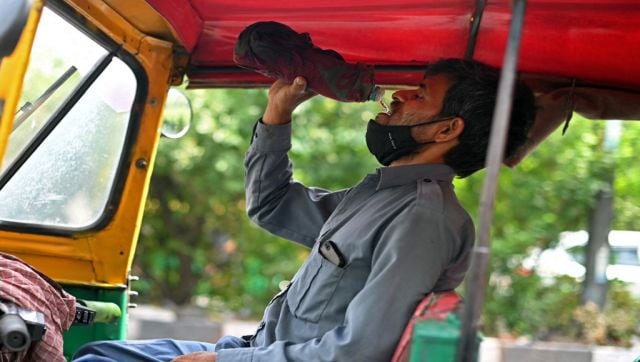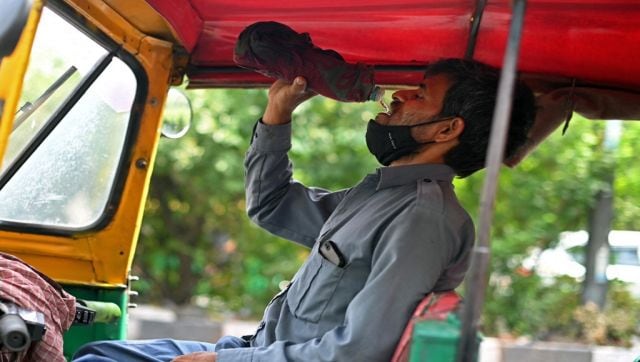In the past week, some areas in Delhi experienced temperatures as high as 49 degrees Celsius, while in some other greener parts of the city the mercury hovered around 45 degrees Celsius. The phenomenon called ‘urban heat islands’ was recently mentioned by NASA in a tweet as it highlighted the difference

An auto rickshaw driver drinks water as he takes a break on a hot summer day in New Delhi. AFP
As several parts of the country continue to reel under severe heatwave conditions, a new term has entered the common parlance to describe urban areas such as Delhi that are a lot hotter than their adjoining rural areas.
The phenomenon called “urban heat islands” was recently mentioned by NASA in a tweet as it highlighted the massive temperature difference between Delhi and its nearby areas.
Cities are often markedly warmer than the countryside, and that’s critical in a heat wave. This image, taken by @NASA‘s ECOSTRESS instrument on the @Space_Station, shows “heat islands” in and near Delhi, India, with nighttime temps up to 102° F (40° hotter than nearby fields). pic.twitter.com/yjzkdjDYev
— NASA JPL (@NASAJPL) May 12, 2022
Let’s see why cities are hotter than areas around them and what causes the heat island phenomenon:
What is an urban heat island?
According to The Indian Express, an urban heat island is a local and temporary phenomenon experienced when certain pockets within a city experience higher heat load than surrounding or neighbouring areas on the same day.
The temperature difference is generally caused by heat remaining trapped within locations that often resemble concrete jungles.
The temperature variation can range between three to five degrees Celsius.
Why are cities hotter than rural areas?
Cities generally have a relatively smaller green cover in the form of forests, farmlands and trees as compared to rural areas. The green cover in rural areas helps them regulate heat on the ground.
Trees help regulate the heat through a process called transpiration. The roots absorb water from the soil, store it in the leaves and stems of plants before processing it and releasing it in the form of water vapour.
Since cities lack sufficient green cover or gardens, and in addition are developed using materials that trap and store heat for a long time. As a result, cities have either completely absent or very poor heat regulation.
Metal, glass, cement and concrete are such materials that absorb more heat, leading to overall increased temperature of the surroundings.
What does NASA’s data show?
This image, taken by NASA’s ECOSTRESS instrument on the International Space Station showed “heat islands” in and near Delhi with nighttime temps up to 40 degrees hotter than nearby fields.
The image, taken shortly before local midnight on 5 May, showed urban areas and agricultural lands northwest of Delhi that are home to about 28 million people. The image covers about 12,350 square kilometers.
“Cities are usually markedly warmer than the surrounding countryside due to human activities and the materials used in the built environment. The image clearly delineates these urban heat islands,” it said.
Nighttime temperatures in Delhi and several smaller villages were above 35 degrees Celsius, peaking at about 39 degrees Celsius, while the rural fields nearby had cooled to around 15 degrees Celsius.
These data suggest that city dwellers are experiencing considerably higher temperatures than the average temperatures reported for their regions.
Ecostress measures the temperature of the ground itself, which is very similar to air temperature at night. The temperature of the ground tends to be higher during the daytime.
With inputs from agencies
Read all the Latest News, Trending News, Cricket News, Bollywood News,
India News and Entertainment News here. Follow us on Facebook, Twitter and Instagram.







More News
Karnataka Sex Abuse Case: BJP Chief Vijayendra Denies Getting Any Letter Regarding Allegations Against Prajwal Revanna
JD(S) MLA, son of ex prime minister, HD Revanna detained amidst high drama | India News – Times of India
Karnataka Sex Abuse Case: Prajwals Father, JDS MLA HD Revanna Taken Into Custody By SIT